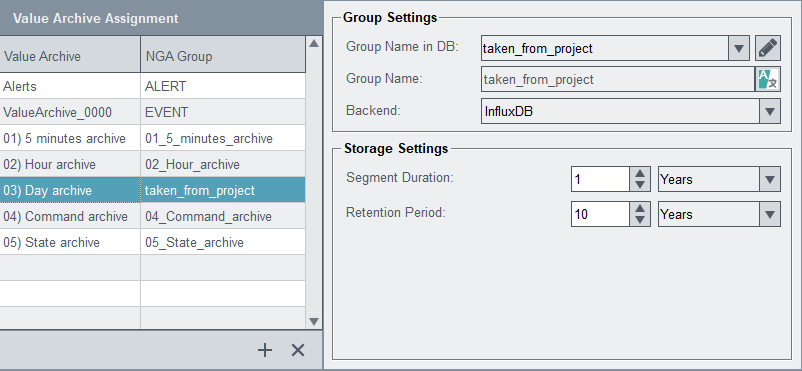NGA archive conversion - Deployment of multiple systems
All settings configured in the NGA migration panel such as the mapping of value archives and RAIMA alerts to NGA groups as well as the group and storage settings are saved in a YAML file.
Optionally, it is possible to provide a template YAML file for the NGA archive conversion which must be located in: <proj path>/dplist/. YAML fields with value '~' are place holders and will be filled according to the actual project settings on startup of the archive conversion panel.
- The fields groups_count, group_dp, alert_group must always contain a value. Otherwise the panel ignores the setting for the value archive data point.
YAML File
_ValueArchive_0:
groups_count: 1
group_dp: EVENT
group_name: ~
display_name: ~
backend: ~
retention_period:
factor: ~
interval: ~
alert_group: 0 Note: The fields group_name, display_name,
backend, retention_period (factor, interval), segment_duration
(factor, interval) can be left empty by using the character '~'.
- The settings from the assigned value archive are used.
Note: The order of the rows cannot be changed and must be kept as in
the example above. Otherwise, the panel ignores the settings for this value archive data
point.
- If you define a group containing place holders '~' as done in the figure above, the group will be marked yellow in the NGA archive conversion panel and the place holder fields are filled based on the project setting.
Example
- Use a YAML file from a different project and update only the following part
group_dp:
Changed YAML file
_ValueArchive_0: groups_count: 1 group_dp: NGA_G_taken_from_project group_name: ~ display_name: ~ backend: ~ retention_period: factor: ~ interval: ~ alert_group: 0
Note: If you do not use the prefix _NGA_G_ for the data
point, it is automatically added!
- The result after reopening the panel:
Figure 1. Changed archive 
- The segment duration and retention period are taken from the settings of the value archive 3.
- The Group Name and Group Name in
DB are derived from the field "group_dp" in the YAML
file.
Figure 2. Settings of the changed group 
Note: If you click on Restore, the direct
settings from the project are used in the panel! The template YAML file is removed
and a new one is created!
Backend Section
In the Backend section, you can specify backends and the database user, the encrypted password for the database, the database port (the default port for
PostgreSQL® is 15432), the backend profile and the display name for the backend. The display name is the name of the backend as it is displayed in the panel (UI). In the example below,
the display name can be seen in several languages.
Note: You can specify several backends in the backend section.
---
_NGA_B_PostgreSQLBackend:
db_user: etm
db_pwd: 5EA988252DC9DFBD6736AC29289AB226
db_port: 15432
backend_profile: PostgreSQLBackend_Profile
display_name: lt:3 LANG:10001 "PostgreSQLBackend" LANG:10000 "PostgreSQLBackend" LANG:10027 "PostgreSQLBackend"


